fuse diagram JEEP XJ 1995 Service And Service Manual
[x] Cancel search | Manufacturer: JEEP, Model Year: 1995, Model line: XJ, Model: JEEP XJ 1995Pages: 2158, PDF Size: 81.9 MB
Page 677 of 2158
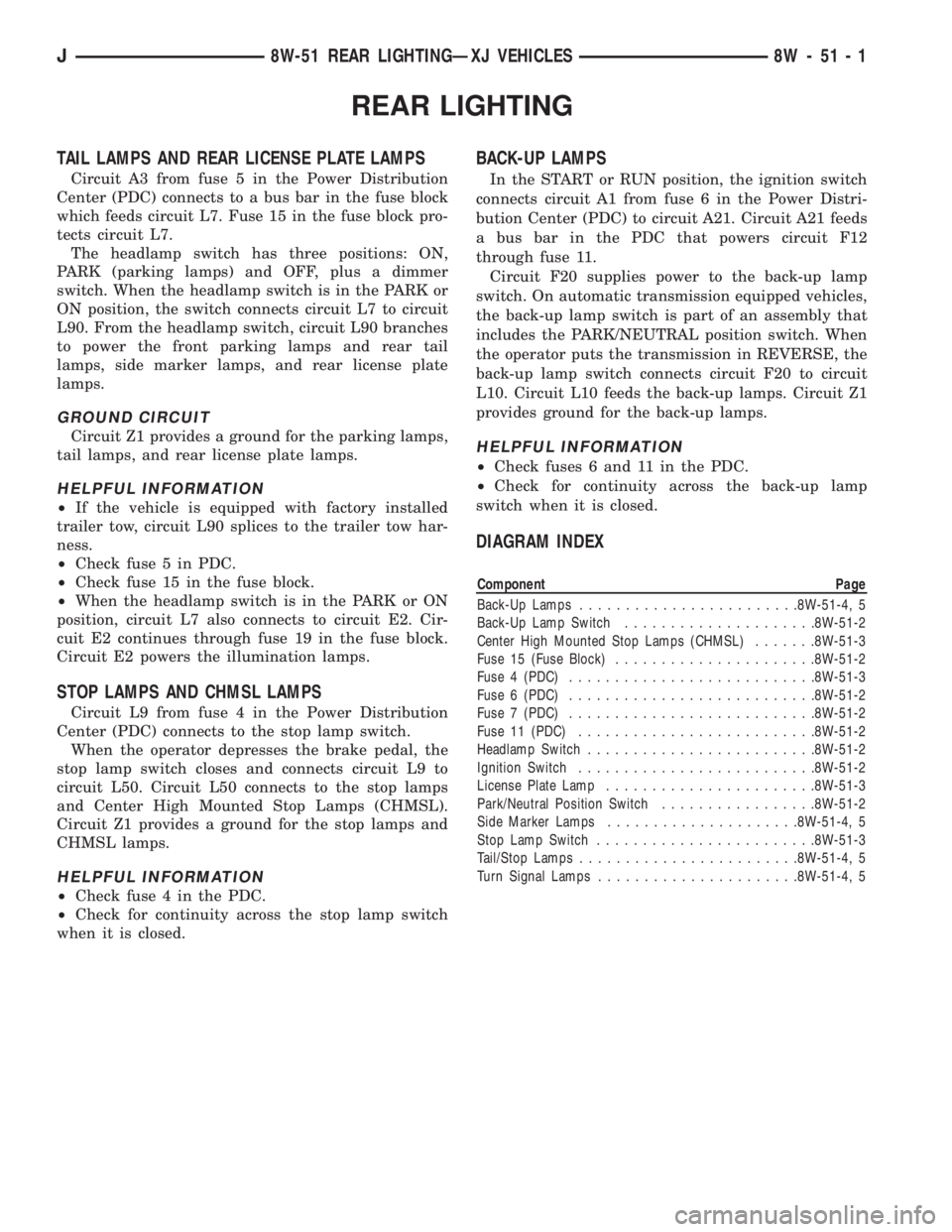
REAR LIGHTING
TAIL LAMPS AND REAR LICENSE PLATE LAMPS
Circuit A3 from fuse 5 in the Power Distribution
Center (PDC) connects to a bus bar in the fuse block
which feeds circuit L7. Fuse 15 in the fuse block pro-
tects circuit L7.
The headlamp switch has three positions: ON,
PARK (parking lamps) and OFF, plus a dimmer
switch. When the headlamp switch is in the PARK or
ON position, the switch connects circuit L7 to circuit
L90. From the headlamp switch, circuit L90 branches
to power the front parking lamps and rear tail
lamps, side marker lamps, and rear license plate
lamps.
GROUND CIRCUIT
Circuit Z1 provides a ground for the parking lamps,
tail lamps, and rear license plate lamps.
HELPFUL INFORMATION
²If the vehicle is equipped with factory installed
trailer tow, circuit L90 splices to the trailer tow har-
ness.
²Check fuse 5 in PDC.
²Check fuse 15 in the fuse block.
²When the headlamp switch is in the PARK or ON
position, circuit L7 also connects to circuit E2. Cir-
cuit E2 continues through fuse 19 in the fuse block.
Circuit E2 powers the illumination lamps.
STOP LAMPS AND CHMSL LAMPS
Circuit L9 from fuse 4 in the Power Distribution
Center (PDC) connects to the stop lamp switch.
When the operator depresses the brake pedal, the
stop lamp switch closes and connects circuit L9 to
circuit L50. Circuit L50 connects to the stop lamps
and Center High Mounted Stop Lamps (CHMSL).
Circuit Z1 provides a ground for the stop lamps and
CHMSL lamps.
HELPFUL INFORMATION
²Check fuse 4 in the PDC.
²Check for continuity across the stop lamp switch
when it is closed.
BACK-UP LAMPS
In the START or RUN position, the ignition switch
connects circuit A1 from fuse 6 in the Power Distri-
bution Center (PDC) to circuit A21. Circuit A21 feeds
a bus bar in the PDC that powers circuit F12
through fuse 11.
Circuit F20 supplies power to the back-up lamp
switch. On automatic transmission equipped vehicles,
the back-up lamp switch is part of an assembly that
includes the PARK/NEUTRAL position switch. When
the operator puts the transmission in REVERSE, the
back-up lamp switch connects circuit F20 to circuit
L10. Circuit L10 feeds the back-up lamps. Circuit Z1
provides ground for the back-up lamps.
HELPFUL INFORMATION
²Check fuses 6 and 11 in the PDC.
²Check for continuity across the back-up lamp
switch when it is closed.
DIAGRAM INDEX
Component Page
Back-Up Lamps........................8W-51-4, 5
Back-Up Lamp Switch.....................8W-51-2
Center High Mounted Stop Lamps (CHMSL).......8W-51-3
Fuse 15 (Fuse Block)......................8W-51-2
Fuse 4 (PDC)...........................8W-51-3
Fuse 6 (PDC)...........................8W-51-2
Fuse 7 (PDC)...........................8W-51-2
Fuse 11 (PDC)..........................8W-51-2
Headlamp Switch.........................8W-51-2
Ignition Switch..........................8W-51-2
License Plate Lamp.......................8W-51-3
Park/Neutral Position Switch.................8W-51-2
Side Marker Lamps.....................8W-51-4, 5
Stop Lamp Switch........................8W-51-3
Tail/Stop Lamps........................8W-51-4, 5
Turn Signal Lamps......................8W-51-4, 5
J8W-51 REAR LIGHTINGÐXJ VEHICLES 8W - 51 - 1
Page 682 of 2158
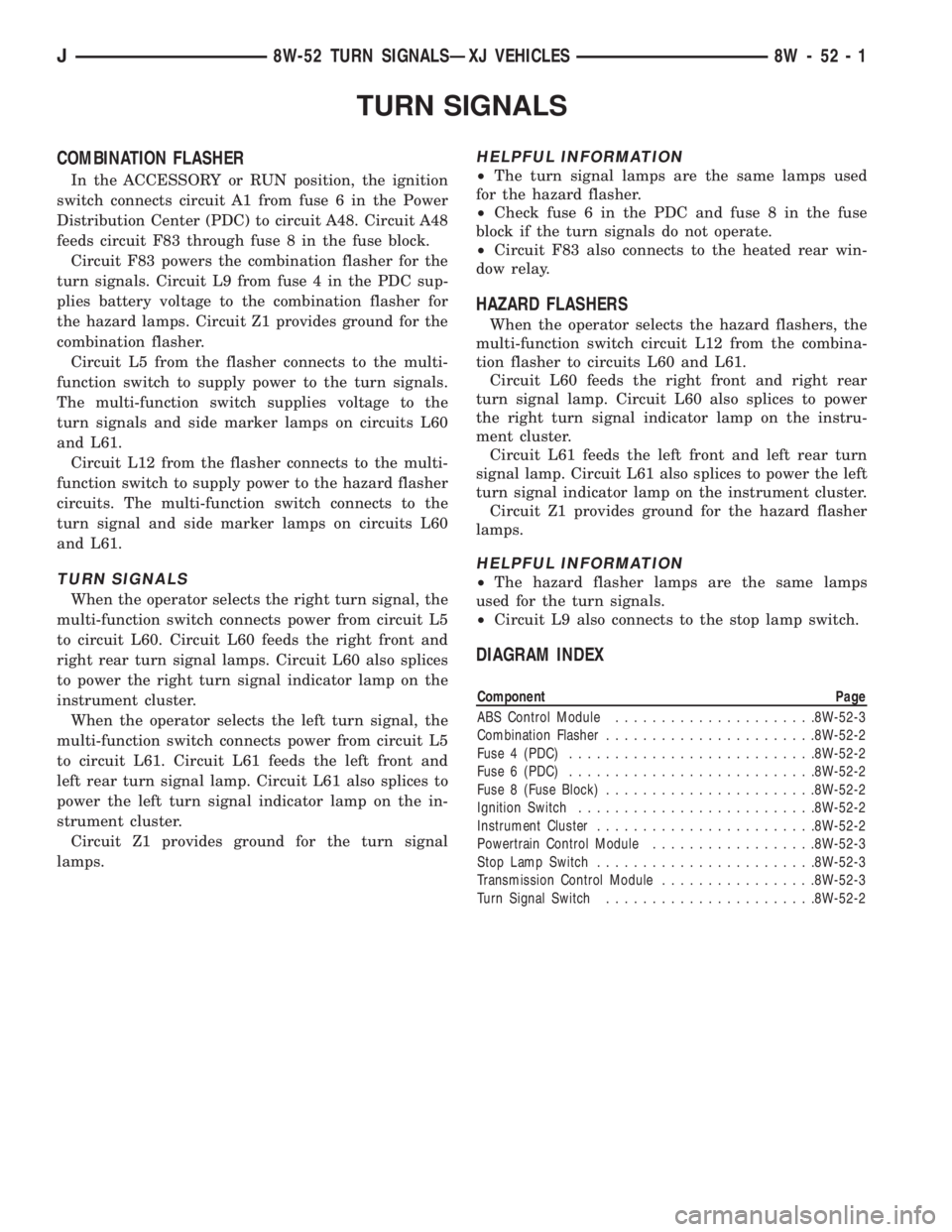
TURN SIGNALS
COMBINATION FLASHER
In the ACCESSORY or RUN position, the ignition
switch connects circuit A1 from fuse 6 in the Power
Distribution Center (PDC) to circuit A48. Circuit A48
feeds circuit F83 through fuse 8 in the fuse block.
Circuit F83 powers the combination flasher for the
turn signals. Circuit L9 from fuse 4 in the PDC sup-
plies battery voltage to the combination flasher for
the hazard lamps. Circuit Z1 provides ground for the
combination flasher.
Circuit L5 from the flasher connects to the multi-
function switch to supply power to the turn signals.
The multi-function switch supplies voltage to the
turn signals and side marker lamps on circuits L60
and L61.
Circuit L12 from the flasher connects to the multi-
function switch to supply power to the hazard flasher
circuits. The multi-function switch connects to the
turn signal and side marker lamps on circuits L60
and L61.
TURN SIGNALS
When the operator selects the right turn signal, the
multi-function switch connects power from circuit L5
to circuit L60. Circuit L60 feeds the right front and
right rear turn signal lamps. Circuit L60 also splices
to power the right turn signal indicator lamp on the
instrument cluster.
When the operator selects the left turn signal, the
multi-function switch connects power from circuit L5
to circuit L61. Circuit L61 feeds the left front and
left rear turn signal lamp. Circuit L61 also splices to
power the left turn signal indicator lamp on the in-
strument cluster.
Circuit Z1 provides ground for the turn signal
lamps.
HELPFUL INFORMATION
²The turn signal lamps are the same lamps used
for the hazard flasher.
²Check fuse 6 in the PDC and fuse 8 in the fuse
block if the turn signals do not operate.
²Circuit F83 also connects to the heated rear win-
dow relay.
HAZARD FLASHERS
When the operator selects the hazard flashers, the
multi-function switch circuit L12 from the combina-
tion flasher to circuits L60 and L61.
Circuit L60 feeds the right front and right rear
turn signal lamp. Circuit L60 also splices to power
the right turn signal indicator lamp on the instru-
ment cluster.
Circuit L61 feeds the left front and left rear turn
signal lamp. Circuit L61 also splices to power the left
turn signal indicator lamp on the instrument cluster.
Circuit Z1 provides ground for the hazard flasher
lamps.
HELPFUL INFORMATION
²The hazard flasher lamps are the same lamps
used for the turn signals.
²Circuit L9 also connects to the stop lamp switch.
DIAGRAM INDEX
Component Page
ABS Control Module......................8W-52-3
Combination Flasher.......................8W-52-2
Fuse 4 (PDC)...........................8W-52-2
Fuse 6 (PDC)...........................8W-52-2
Fuse 8 (Fuse Block).......................8W-52-2
Ignition Switch..........................8W-52-2
Instrument Cluster........................8W-52-2
Powertrain Control Module..................8W-52-3
Stop Lamp Switch........................8W-52-3
Transmission Control Module.................8W-52-3
Turn Signal Switch.......................8W-52-2
J8W-52 TURN SIGNALSÐXJ VEHICLES 8W - 52 - 1
Page 685 of 2158
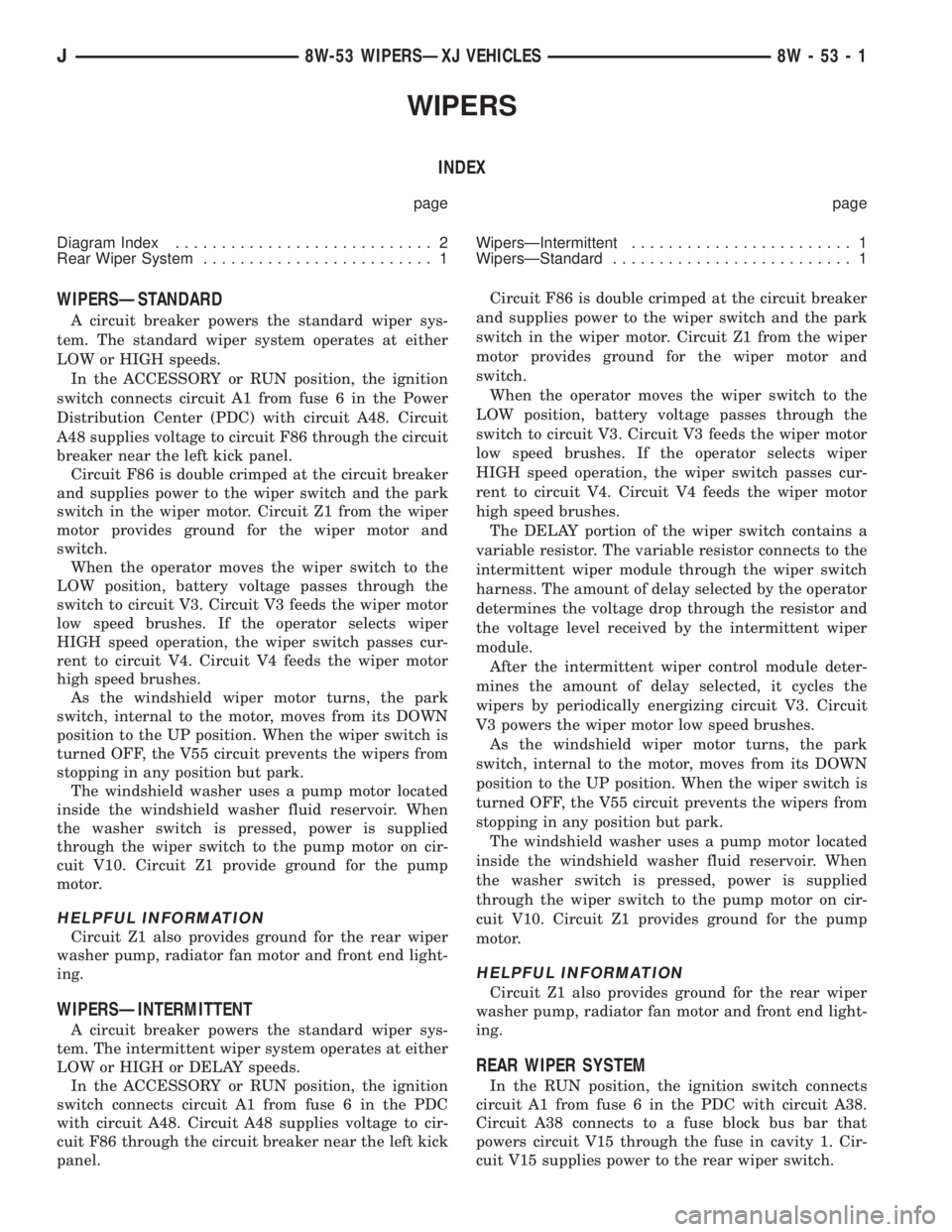
WIPERS
INDEX
page page
Diagram Index............................ 2
Rear Wiper System......................... 1WipersÐIntermittent........................ 1
WipersÐStandard.......................... 1
WIPERSÐSTANDARD
A circuit breaker powers the standard wiper sys-
tem. The standard wiper system operates at either
LOW or HIGH speeds.
In the ACCESSORY or RUN position, the ignition
switch connects circuit A1 from fuse 6 in the Power
Distribution Center (PDC) with circuit A48. Circuit
A48 supplies voltage to circuit F86 through the circuit
breaker near the left kick panel.
Circuit F86 is double crimped at the circuit breaker
and supplies power to the wiper switch and the park
switch in the wiper motor. Circuit Z1 from the wiper
motor provides ground for the wiper motor and
switch.
When the operator moves the wiper switch to the
LOW position, battery voltage passes through the
switch to circuit V3. Circuit V3 feeds the wiper motor
low speed brushes. If the operator selects wiper
HIGH speed operation, the wiper switch passes cur-
rent to circuit V4. Circuit V4 feeds the wiper motor
high speed brushes.
As the windshield wiper motor turns, the park
switch, internal to the motor, moves from its DOWN
position to the UP position. When the wiper switch is
turned OFF, the V55 circuit prevents the wipers from
stopping in any position but park.
The windshield washer uses a pump motor located
inside the windshield washer fluid reservoir. When
the washer switch is pressed, power is supplied
through the wiper switch to the pump motor on cir-
cuit V10. Circuit Z1 provide ground for the pump
motor.
HELPFUL INFORMATION
Circuit Z1 also provides ground for the rear wiper
washer pump, radiator fan motor and front end light-
ing.
WIPERSÐINTERMITTENT
A circuit breaker powers the standard wiper sys-
tem. The intermittent wiper system operates at either
LOW or HIGH or DELAY speeds.
In the ACCESSORY or RUN position, the ignition
switch connects circuit A1 from fuse 6 in the PDC
with circuit A48. Circuit A48 supplies voltage to cir-
cuit F86 through the circuit breaker near the left kick
panel.Circuit F86 is double crimped at the circuit breaker
and supplies power to the wiper switch and the park
switch in the wiper motor. Circuit Z1 from the wiper
motor provides ground for the wiper motor and
switch.
When the operator moves the wiper switch to the
LOW position, battery voltage passes through the
switch to circuit V3. Circuit V3 feeds the wiper motor
low speed brushes. If the operator selects wiper
HIGH speed operation, the wiper switch passes cur-
rent to circuit V4. Circuit V4 feeds the wiper motor
high speed brushes.
The DELAY portion of the wiper switch contains a
variable resistor. The variable resistor connects to the
intermittent wiper module through the wiper switch
harness. The amount of delay selected by the operator
determines the voltage drop through the resistor and
the voltage level received by the intermittent wiper
module.
After the intermittent wiper control module deter-
mines the amount of delay selected, it cycles the
wipers by periodically energizing circuit V3. Circuit
V3 powers the wiper motor low speed brushes.
As the windshield wiper motor turns, the park
switch, internal to the motor, moves from its DOWN
position to the UP position. When the wiper switch is
turned OFF, the V55 circuit prevents the wipers from
stopping in any position but park.
The windshield washer uses a pump motor located
inside the windshield washer fluid reservoir. When
the washer switch is pressed, power is supplied
through the wiper switch to the pump motor on cir-
cuit V10. Circuit Z1 provides ground for the pump
motor.
HELPFUL INFORMATION
Circuit Z1 also provides ground for the rear wiper
washer pump, radiator fan motor and front end light-
ing.
REAR WIPER SYSTEM
In the RUN position, the ignition switch connects
circuit A1 from fuse 6 in the PDC with circuit A38.
Circuit A38 connects to a fuse block bus bar that
powers circuit V15 through the fuse in cavity 1. Cir-
cuit V15 supplies power to the rear wiper switch.
J8W-53 WIPERSÐXJ VEHICLES 8W - 53 - 1
Page 686 of 2158
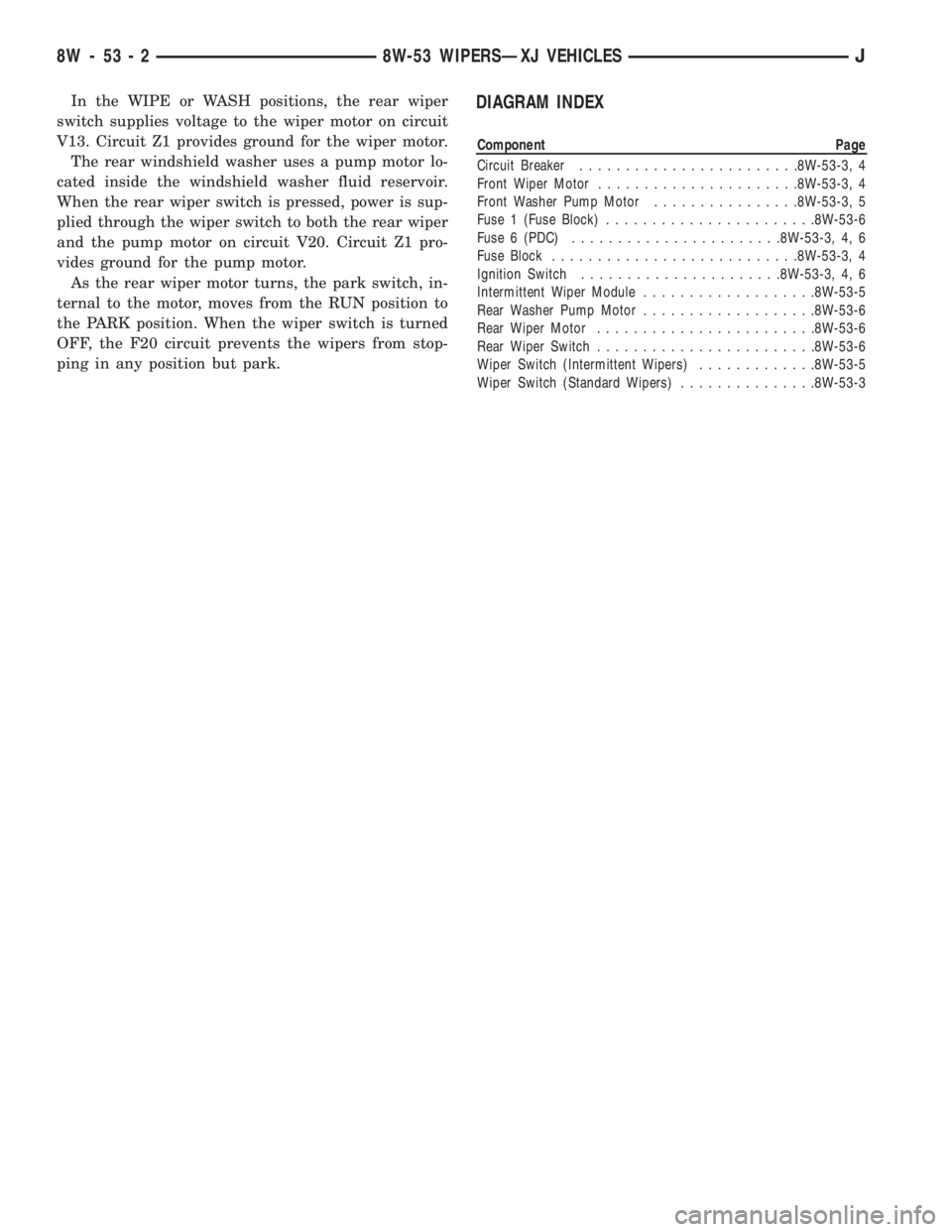
In the WIPE or WASH positions, the rear wiper
switch supplies voltage to the wiper motor on circuit
V13. Circuit Z1 provides ground for the wiper motor.
The rear windshield washer uses a pump motor lo-
cated inside the windshield washer fluid reservoir.
When the rear wiper switch is pressed, power is sup-
plied through the wiper switch to both the rear wiper
and the pump motor on circuit V20. Circuit Z1 pro-
vides ground for the pump motor.
As the rear wiper motor turns, the park switch, in-
ternal to the motor, moves from the RUN position to
the PARK position. When the wiper switch is turned
OFF, the F20 circuit prevents the wipers from stop-
ping in any position but park.DIAGRAM INDEX
Component Page
Circuit Breaker........................8W-53-3, 4
Front Wiper Motor......................8W-53-3, 4
Front Washer Pump Motor................8W-53-3, 5
Fuse 1 (Fuse Block).......................8W-53-6
Fuse 6 (PDC).......................8W-53-3, 4, 6
Fuse Block...........................8W-53-3, 4
Ignition Switch......................8W-53-3, 4, 6
Intermittent Wiper Module...................8W-53-5
Rear Washer Pump Motor...................8W-53-6
Rear Wiper Motor........................8W-53-6
Rear Wiper Switch........................8W-53-6
Wiper Switch (Intermittent Wipers).............8W-53-5
Wiper Switch (Standard Wipers)...............8W-53-3
8W - 53 - 2 8W-53 WIPERSÐXJ VEHICLESJ
Page 691 of 2158
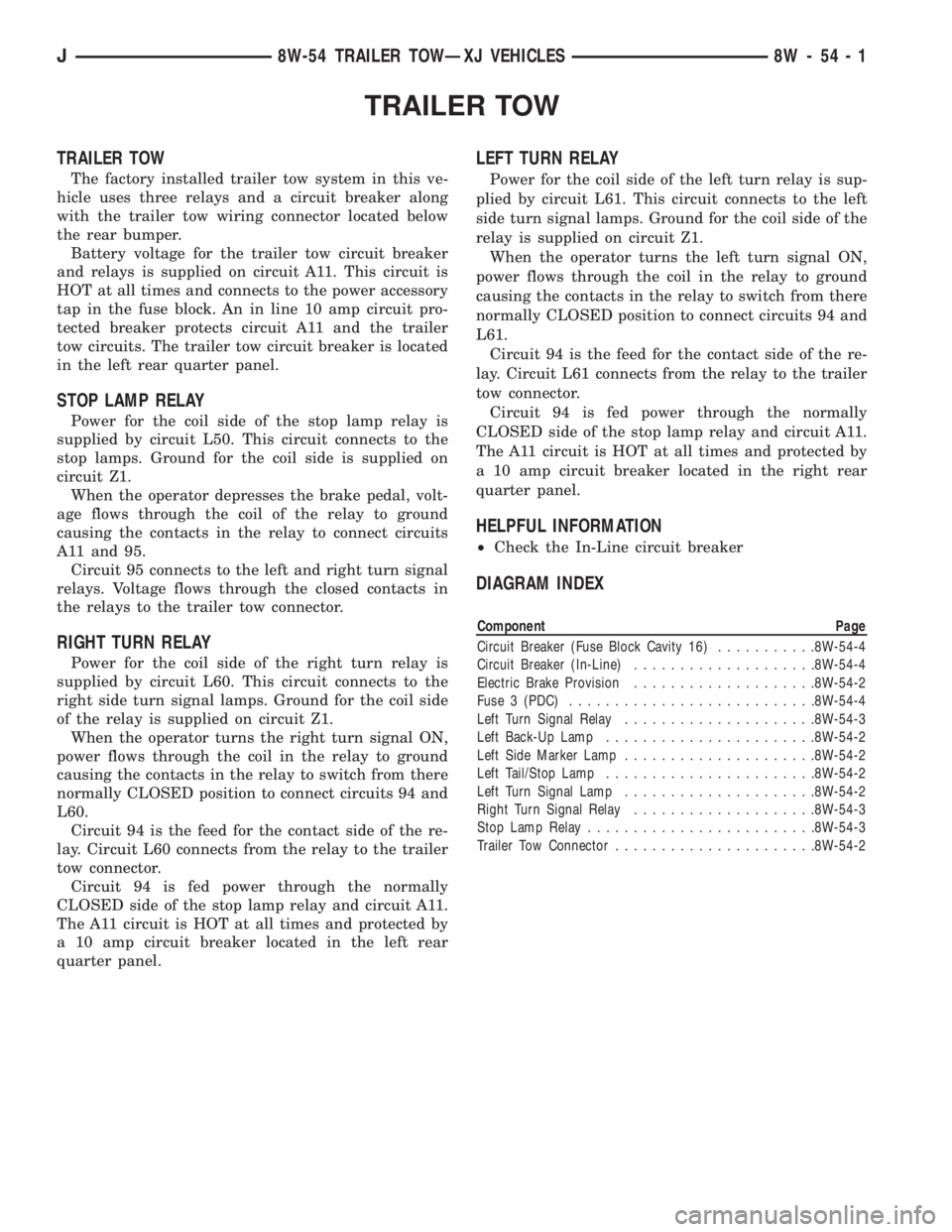
TRAILER TOW
TRAILER TOW
The factory installed trailer tow system in this ve-
hicle uses three relays and a circuit breaker along
with the trailer tow wiring connector located below
the rear bumper.
Battery voltage for the trailer tow circuit breaker
and relays is supplied on circuit A11. This circuit is
HOT at all times and connects to the power accessory
tap in the fuse block. An in line 10 amp circuit pro-
tected breaker protects circuit A11 and the trailer
tow circuits. The trailer tow circuit breaker is located
in the left rear quarter panel.
STOP LAMP RELAY
Power for the coil side of the stop lamp relay is
supplied by circuit L50. This circuit connects to the
stop lamps. Ground for the coil side is supplied on
circuit Z1.
When the operator depresses the brake pedal, volt-
age flows through the coil of the relay to ground
causing the contacts in the relay to connect circuits
A11 and 95.
Circuit 95 connects to the left and right turn signal
relays. Voltage flows through the closed contacts in
the relays to the trailer tow connector.
RIGHT TURN RELAY
Power for the coil side of the right turn relay is
supplied by circuit L60. This circuit connects to the
right side turn signal lamps. Ground for the coil side
of the relay is supplied on circuit Z1.
When the operator turns the right turn signal ON,
power flows through the coil in the relay to ground
causing the contacts in the relay to switch from there
normally CLOSED position to connect circuits 94 and
L60.
Circuit 94 is the feed for the contact side of the re-
lay. Circuit L60 connects from the relay to the trailer
tow connector.
Circuit 94 is fed power through the normally
CLOSED side of the stop lamp relay and circuit A11.
The A11 circuit is HOT at all times and protected by
a 10 amp circuit breaker located in the left rear
quarter panel.
LEFT TURN RELAY
Power for the coil side of the left turn relay is sup-
plied by circuit L61. This circuit connects to the left
side turn signal lamps. Ground for the coil side of the
relay is supplied on circuit Z1.
When the operator turns the left turn signal ON,
power flows through the coil in the relay to ground
causing the contacts in the relay to switch from there
normally CLOSED position to connect circuits 94 and
L61.
Circuit 94 is the feed for the contact side of the re-
lay. Circuit L61 connects from the relay to the trailer
tow connector.
Circuit 94 is fed power through the normally
CLOSED side of the stop lamp relay and circuit A11.
The A11 circuit is HOT at all times and protected by
a 10 amp circuit breaker located in the right rear
quarter panel.
HELPFUL INFORMATION
²Check the In-Line circuit breaker
DIAGRAM INDEX
Component Page
Circuit Breaker (Fuse Block Cavity 16)...........8W-54-4
Circuit Breaker (In-Line)....................8W-54-4
Electric Brake Provision....................8W-54-2
Fuse 3 (PDC)...........................8W-54-4
Left Turn Signal Relay.....................8W-54-3
Left Back-Up Lamp.......................8W-54-2
Left Side Marker Lamp.....................8W-54-2
Left Tail/Stop Lamp.......................8W-54-2
Left Turn Signal Lamp.....................8W-54-2
Right Turn Signal Relay....................8W-54-3
Stop Lamp Relay.........................8W-54-3
Trailer Tow Connector......................8W-54-2
J8W-54 TRAILER TOWÐXJ VEHICLES 8W - 54 - 1
Page 695 of 2158
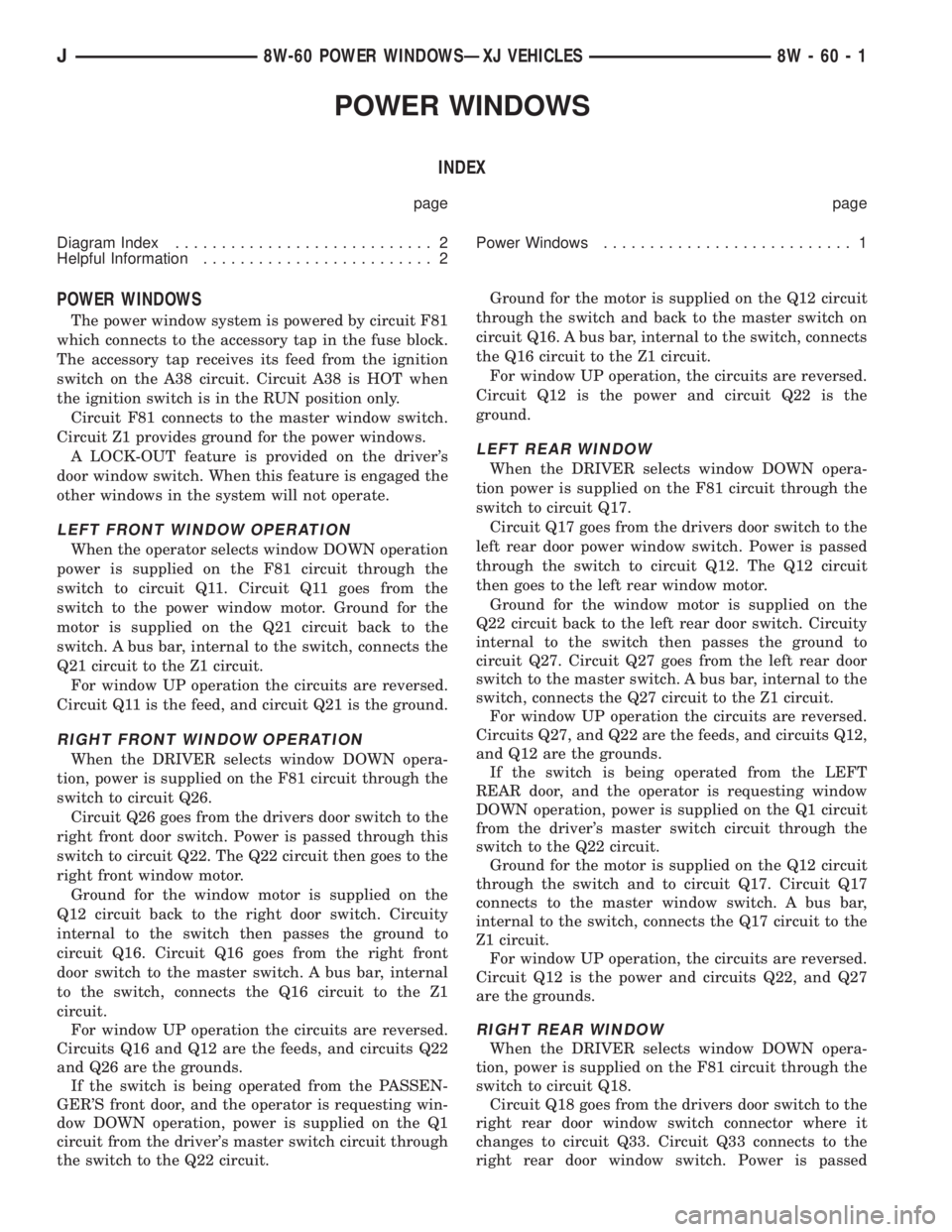
POWER WINDOWS
INDEX
page page
Diagram Index............................ 2
Helpful Information......................... 2Power Windows........................... 1
POWER WINDOWS
The power window system is powered by circuit F81
which connects to the accessory tap in the fuse block.
The accessory tap receives its feed from the ignition
switch on the A38 circuit. Circuit A38 is HOT when
the ignition switch is in the RUN position only.
Circuit F81 connects to the master window switch.
Circuit Z1 provides ground for the power windows.
A LOCK-OUT feature is provided on the driver's
door window switch. When this feature is engaged the
other windows in the system will not operate.
LEFT FRONT WINDOW OPERATION
When the operator selects window DOWN operation
power is supplied on the F81 circuit through the
switch to circuit Q11. Circuit Q11 goes from the
switch to the power window motor. Ground for the
motor is supplied on the Q21 circuit back to the
switch. A bus bar, internal to the switch, connects the
Q21 circuit to the Z1 circuit.
For window UP operation the circuits are reversed.
Circuit Q11 is the feed, and circuit Q21 is the ground.
RIGHT FRONT WINDOW OPERATION
When the DRIVER selects window DOWN opera-
tion, power is supplied on the F81 circuit through the
switch to circuit Q26.
Circuit Q26 goes from the drivers door switch to the
right front door switch. Power is passed through this
switch to circuit Q22. The Q22 circuit then goes to the
right front window motor.
Ground for the window motor is supplied on the
Q12 circuit back to the right door switch. Circuity
internal to the switch then passes the ground to
circuit Q16. Circuit Q16 goes from the right front
door switch to the master switch. A bus bar, internal
to the switch, connects the Q16 circuit to the Z1
circuit.
For window UP operation the circuits are reversed.
Circuits Q16 and Q12 are the feeds, and circuits Q22
and Q26 are the grounds.
If the switch is being operated from the PASSEN-
GER'S front door, and the operator is requesting win-
dow DOWN operation, power is supplied on the Q1
circuit from the driver's master switch circuit through
the switch to the Q22 circuit.Ground for the motor is supplied on the Q12 circuit
through the switch and back to the master switch on
circuit Q16. A bus bar, internal to the switch, connects
the Q16 circuit to the Z1 circuit.
For window UP operation, the circuits are reversed.
Circuit Q12 is the power and circuit Q22 is the
ground.
LEFT REAR WINDOW
When the DRIVER selects window DOWN opera-
tion power is supplied on the F81 circuit through the
switch to circuit Q17.
Circuit Q17 goes from the drivers door switch to the
left rear door power window switch. Power is passed
through the switch to circuit Q12. The Q12 circuit
then goes to the left rear window motor.
Ground for the window motor is supplied on the
Q22 circuit back to the left rear door switch. Circuity
internal to the switch then passes the ground to
circuit Q27. Circuit Q27 goes from the left rear door
switch to the master switch. A bus bar, internal to the
switch, connects the Q27 circuit to the Z1 circuit.
For window UP operation the circuits are reversed.
Circuits Q27, and Q22 are the feeds, and circuits Q12,
and Q12 are the grounds.
If the switch is being operated from the LEFT
REAR door, and the operator is requesting window
DOWN operation, power is supplied on the Q1 circuit
from the driver's master switch circuit through the
switch to the Q22 circuit.
Ground for the motor is supplied on the Q12 circuit
through the switch and to circuit Q17. Circuit Q17
connects to the master window switch. A bus bar,
internal to the switch, connects the Q17 circuit to the
Z1 circuit.
For window UP operation, the circuits are reversed.
Circuit Q12 is the power and circuits Q22, and Q27
are the grounds.
RIGHT REAR WINDOW
When the DRIVER selects window DOWN opera-
tion, power is supplied on the F81 circuit through the
switch to circuit Q18.
Circuit Q18 goes from the drivers door switch to the
right rear door window switch connector where it
changes to circuit Q33. Circuit Q33 connects to the
right rear door window switch. Power is passed
J8W-60 POWER WINDOWSÐXJ VEHICLES 8W - 60 - 1
Page 696 of 2158
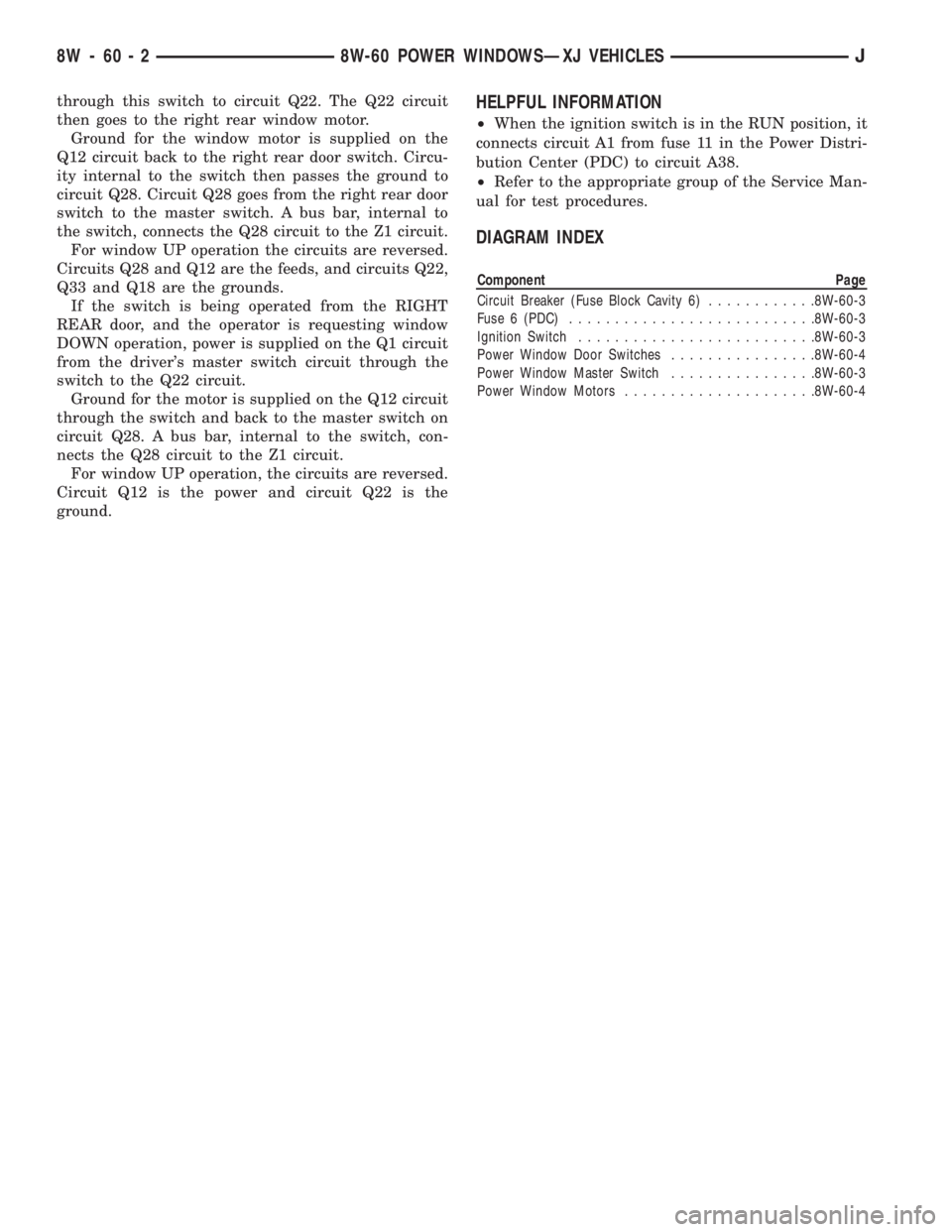
through this switch to circuit Q22. The Q22 circuit
then goes to the right rear window motor.
Ground for the window motor is supplied on the
Q12 circuit back to the right rear door switch. Circu-
ity internal to the switch then passes the ground to
circuit Q28. Circuit Q28 goes from the right rear door
switch to the master switch. A bus bar, internal to
the switch, connects the Q28 circuit to the Z1 circuit.
For window UP operation the circuits are reversed.
Circuits Q28 and Q12 are the feeds, and circuits Q22,
Q33 and Q18 are the grounds.
If the switch is being operated from the RIGHT
REAR door, and the operator is requesting window
DOWN operation, power is supplied on the Q1 circuit
from the driver's master switch circuit through the
switch to the Q22 circuit.
Ground for the motor is supplied on the Q12 circuit
through the switch and back to the master switch on
circuit Q28. A bus bar, internal to the switch, con-
nects the Q28 circuit to the Z1 circuit.
For window UP operation, the circuits are reversed.
Circuit Q12 is the power and circuit Q22 is the
ground.HELPFUL INFORMATION
²When the ignition switch is in the RUN position, it
connects circuit A1 from fuse 11 in the Power Distri-
bution Center (PDC) to circuit A38.
²Refer to the appropriate group of the Service Man-
ual for test procedures.
DIAGRAM INDEX
Component Page
Circuit Breaker (Fuse Block Cavity 6)............8W-60-3
Fuse 6 (PDC)...........................8W-60-3
Ignition Switch..........................8W-60-3
Power Window Door Switches................8W-60-4
Power Window Master Switch................8W-60-3
Power Window Motors.....................8W-60-4
8W - 60 - 2 8W-60 POWER WINDOWSÐXJ VEHICLESJ
Page 699 of 2158
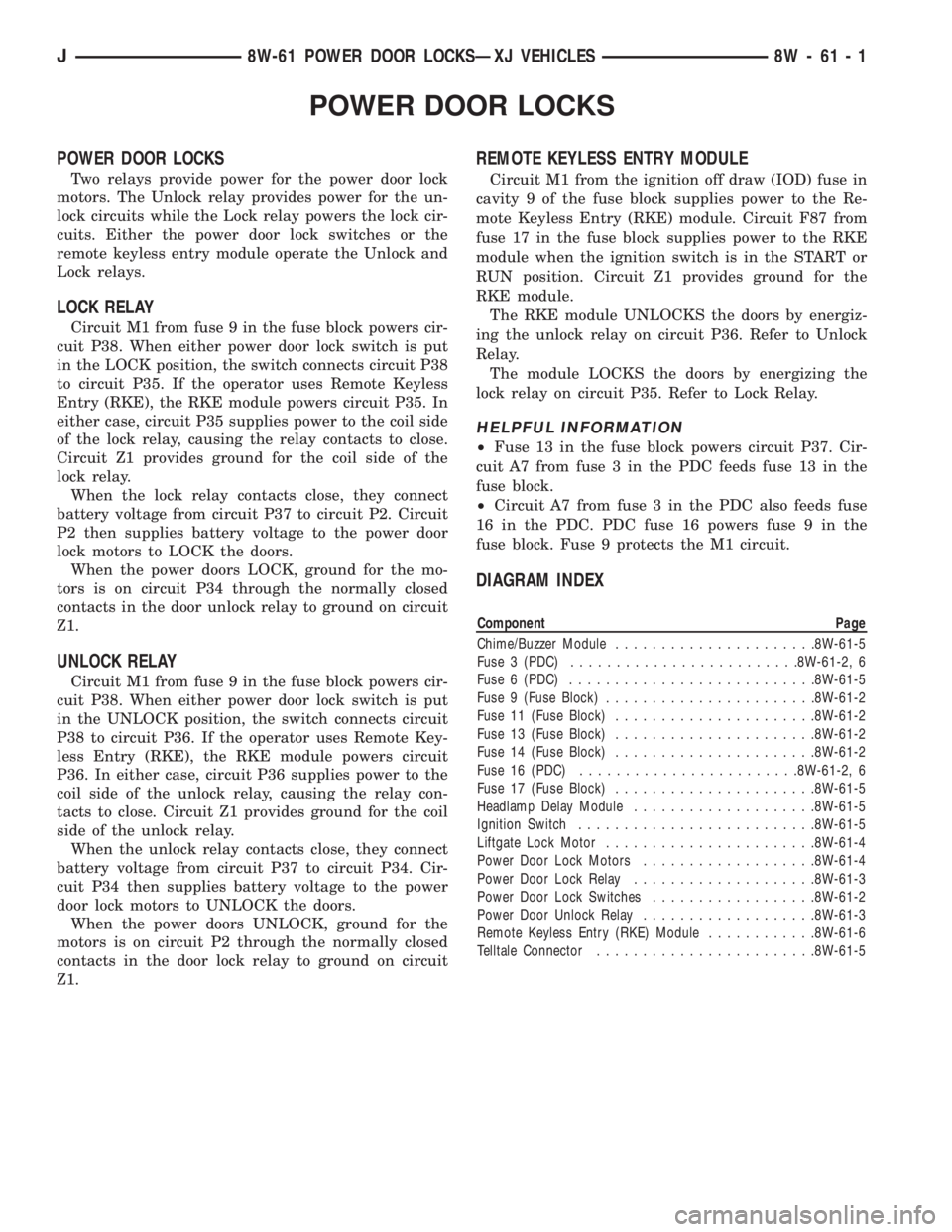
POWER DOOR LOCKS
POWER DOOR LOCKS
Two relays provide power for the power door lock
motors. The Unlock relay provides power for the un-
lock circuits while the Lock relay powers the lock cir-
cuits. Either the power door lock switches or the
remote keyless entry module operate the Unlock and
Lock relays.
LOCK RELAY
Circuit M1 from fuse 9 in the fuse block powers cir-
cuit P38. When either power door lock switch is put
in the LOCK position, the switch connects circuit P38
to circuit P35. If the operator uses Remote Keyless
Entry (RKE), the RKE module powers circuit P35. In
either case, circuit P35 supplies power to the coil side
of the lock relay, causing the relay contacts to close.
Circuit Z1 provides ground for the coil side of the
lock relay.
When the lock relay contacts close, they connect
battery voltage from circuit P37 to circuit P2. Circuit
P2 then supplies battery voltage to the power door
lock motors to LOCK the doors.
When the power doors LOCK, ground for the mo-
tors is on circuit P34 through the normally closed
contacts in the door unlock relay to ground on circuit
Z1.
UNLOCK RELAY
Circuit M1 from fuse 9 in the fuse block powers cir-
cuit P38. When either power door lock switch is put
in the UNLOCK position, the switch connects circuit
P38 to circuit P36. If the operator uses Remote Key-
less Entry (RKE), the RKE module powers circuit
P36. In either case, circuit P36 supplies power to the
coil side of the unlock relay, causing the relay con-
tacts to close. Circuit Z1 provides ground for the coil
side of the unlock relay.
When the unlock relay contacts close, they connect
battery voltage from circuit P37 to circuit P34. Cir-
cuit P34 then supplies battery voltage to the power
door lock motors to UNLOCK the doors.
When the power doors UNLOCK, ground for the
motors is on circuit P2 through the normally closed
contacts in the door lock relay to ground on circuit
Z1.
REMOTE KEYLESS ENTRY MODULE
Circuit M1 from the ignition off draw (IOD) fuse in
cavity 9 of the fuse block supplies power to the Re-
mote Keyless Entry (RKE) module. Circuit F87 from
fuse 17 in the fuse block supplies power to the RKE
module when the ignition switch is in the START or
RUN position. Circuit Z1 provides ground for the
RKE module.
The RKE module UNLOCKS the doors by energiz-
ing the unlock relay on circuit P36. Refer to Unlock
Relay.
The module LOCKS the doors by energizing the
lock relay on circuit P35. Refer to Lock Relay.
HELPFUL INFORMATION
²Fuse 13 in the fuse block powers circuit P37. Cir-
cuit A7 from fuse 3 in the PDC feeds fuse 13 in the
fuse block.
²Circuit A7 from fuse 3 in the PDC also feeds fuse
16 in the PDC. PDC fuse 16 powers fuse 9 in the
fuse block. Fuse 9 protects the M1 circuit.
DIAGRAM INDEX
Component Page
Chime/Buzzer Module......................8W-61-5
Fuse 3 (PDC).........................8W-61-2, 6
Fuse 6 (PDC)...........................8W-61-5
Fuse 9 (Fuse Block).......................8W-61-2
Fuse 11 (Fuse Block)......................8W-61-2
Fuse 13 (Fuse Block)......................8W-61-2
Fuse 14 (Fuse Block)......................8W-61-2
Fuse 16 (PDC)........................8W-61-2, 6
Fuse 17 (Fuse Block)......................8W-61-5
Headlamp Delay Module....................8W-61-5
Ignition Switch..........................8W-61-5
Liftgate Lock Motor.......................8W-61-4
Power Door Lock Motors...................8W-61-4
Power Door Lock Relay....................8W-61-3
Power Door Lock Switches..................8W-61-2
Power Door Unlock Relay...................8W-61-3
Remote Keyless Entry (RKE) Module............8W-61-6
Telltale Connector........................8W-61-5
J8W-61 POWER DOOR LOCKSÐXJ VEHICLES 8W - 61 - 1
Page 705 of 2158
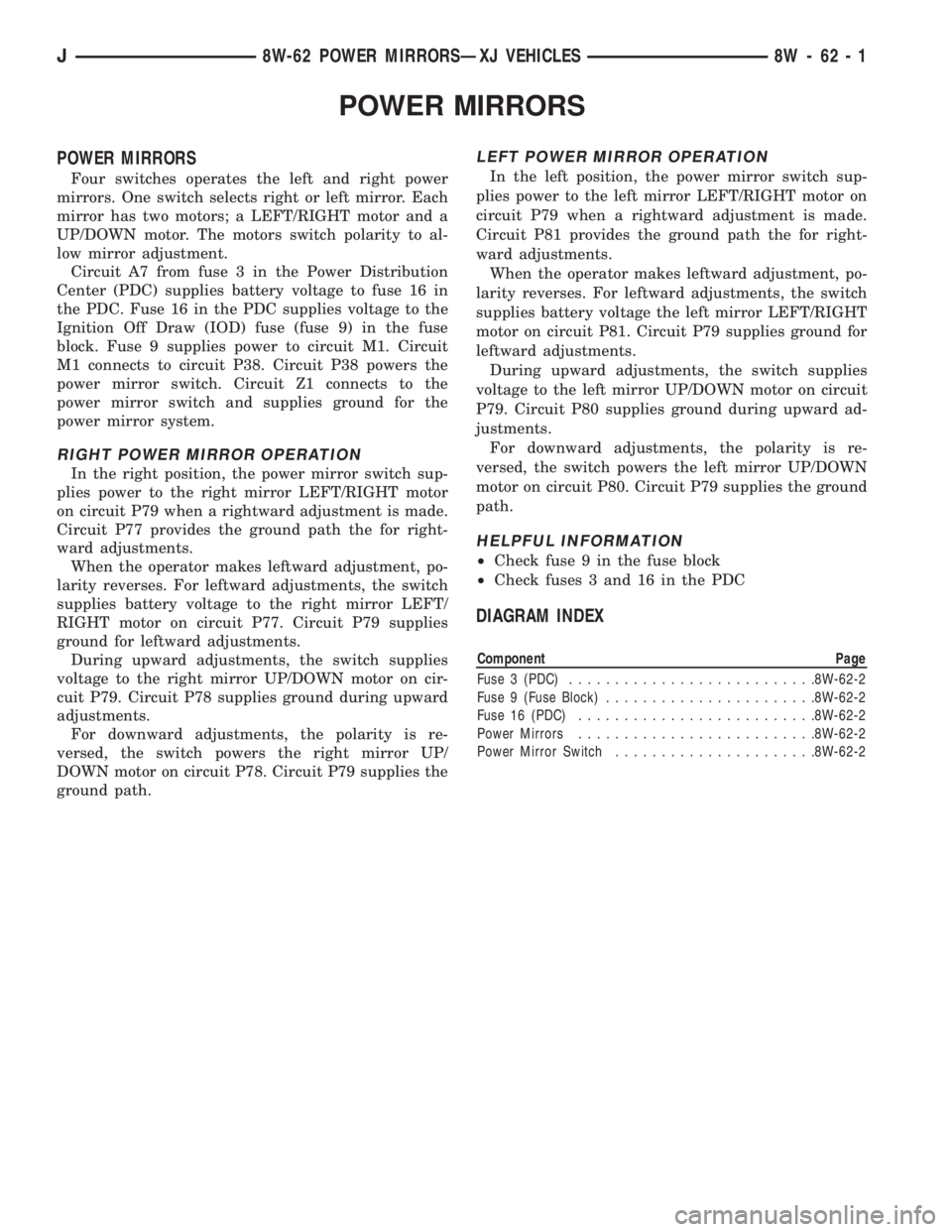
POWER MIRRORS
POWER MIRRORS
Four switches operates the left and right power
mirrors. One switch selects right or left mirror. Each
mirror has two motors; a LEFT/RIGHT motor and a
UP/DOWN motor. The motors switch polarity to al-
low mirror adjustment.
Circuit A7 from fuse 3 in the Power Distribution
Center (PDC) supplies battery voltage to fuse 16 in
the PDC. Fuse 16 in the PDC supplies voltage to the
Ignition Off Draw (IOD) fuse (fuse 9) in the fuse
block. Fuse 9 supplies power to circuit M1. Circuit
M1 connects to circuit P38. Circuit P38 powers the
power mirror switch. Circuit Z1 connects to the
power mirror switch and supplies ground for the
power mirror system.
RIGHT POWER MIRROR OPERATION
In the right position, the power mirror switch sup-
plies power to the right mirror LEFT/RIGHT motor
on circuit P79 when a rightward adjustment is made.
Circuit P77 provides the ground path the for right-
ward adjustments.
When the operator makes leftward adjustment, po-
larity reverses. For leftward adjustments, the switch
supplies battery voltage to the right mirror LEFT/
RIGHT motor on circuit P77. Circuit P79 supplies
ground for leftward adjustments.
During upward adjustments, the switch supplies
voltage to the right mirror UP/DOWN motor on cir-
cuit P79. Circuit P78 supplies ground during upward
adjustments.
For downward adjustments, the polarity is re-
versed, the switch powers the right mirror UP/
DOWN motor on circuit P78. Circuit P79 supplies the
ground path.
LEFT POWER MIRROR OPERATION
In the left position, the power mirror switch sup-
plies power to the left mirror LEFT/RIGHT motor on
circuit P79 when a rightward adjustment is made.
Circuit P81 provides the ground path the for right-
ward adjustments.
When the operator makes leftward adjustment, po-
larity reverses. For leftward adjustments, the switch
supplies battery voltage the left mirror LEFT/RIGHT
motor on circuit P81. Circuit P79 supplies ground for
leftward adjustments.
During upward adjustments, the switch supplies
voltage to the left mirror UP/DOWN motor on circuit
P79. Circuit P80 supplies ground during upward ad-
justments.
For downward adjustments, the polarity is re-
versed, the switch powers the left mirror UP/DOWN
motor on circuit P80. Circuit P79 supplies the ground
path.
HELPFUL INFORMATION
²Check fuse 9 in the fuse block
²Check fuses 3 and 16 in the PDC
DIAGRAM INDEX
Component Page
Fuse 3 (PDC)...........................8W-62-2
Fuse 9 (Fuse Block).......................8W-62-2
Fuse 16 (PDC)..........................8W-62-2
Power Mirrors..........................8W-62-2
Power Mirror Switch......................8W-62-2
J8W-62 POWER MIRRORSÐXJ VEHICLES 8W - 62 - 1
Page 707 of 2158
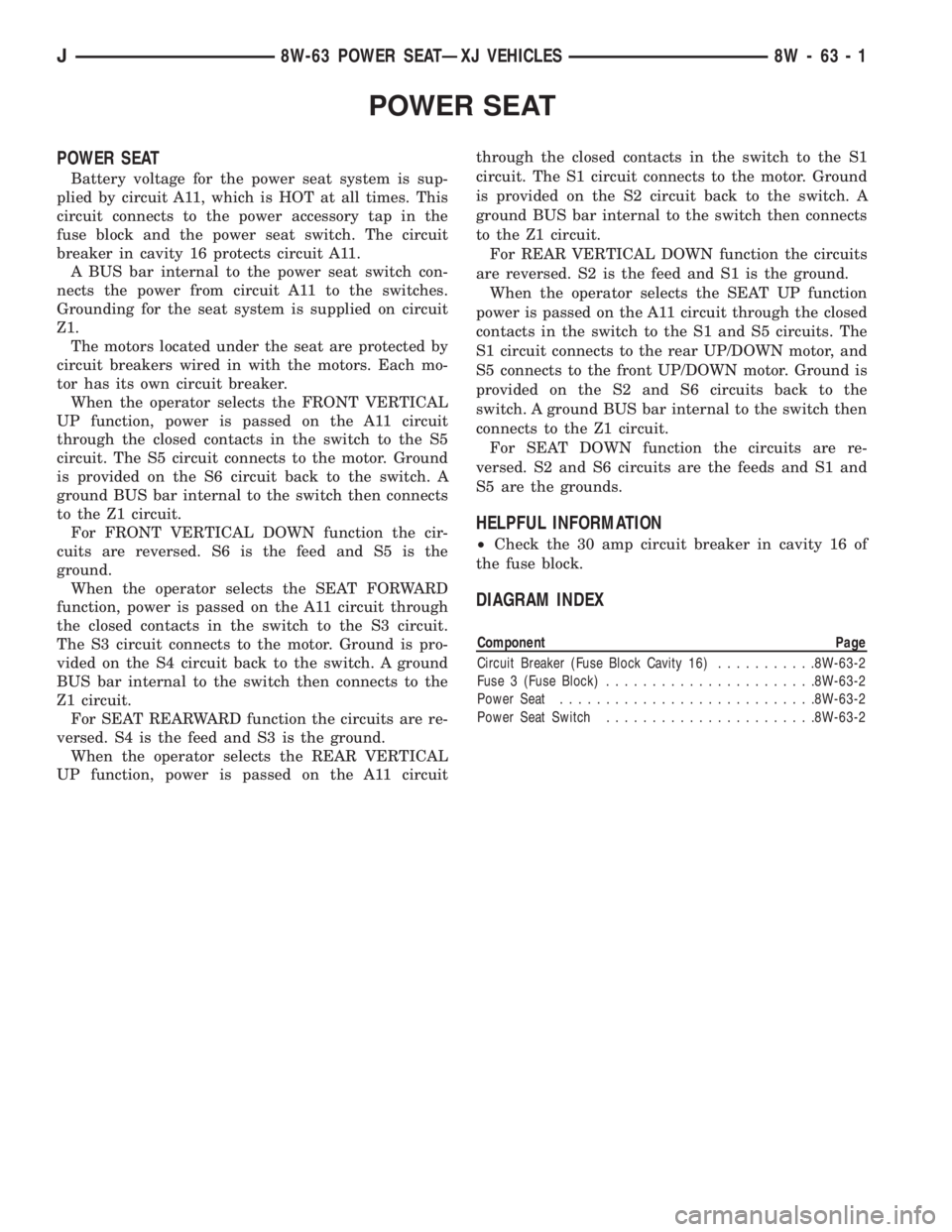
POWER SEAT
POWER SEAT
Battery voltage for the power seat system is sup-
plied by circuit A11, which is HOT at all times. This
circuit connects to the power accessory tap in the
fuse block and the power seat switch. The circuit
breaker in cavity 16 protects circuit A11.
A BUS bar internal to the power seat switch con-
nects the power from circuit A11 to the switches.
Grounding for the seat system is supplied on circuit
Z1.
The motors located under the seat are protected by
circuit breakers wired in with the motors. Each mo-
tor has its own circuit breaker.
When the operator selects the FRONT VERTICAL
UP function, power is passed on the A11 circuit
through the closed contacts in the switch to the S5
circuit. The S5 circuit connects to the motor. Ground
is provided on the S6 circuit back to the switch. A
ground BUS bar internal to the switch then connects
to the Z1 circuit.
For FRONT VERTICAL DOWN function the cir-
cuits are reversed. S6 is the feed and S5 is the
ground.
When the operator selects the SEAT FORWARD
function, power is passed on the A11 circuit through
the closed contacts in the switch to the S3 circuit.
The S3 circuit connects to the motor. Ground is pro-
vided on the S4 circuit back to the switch. A ground
BUS bar internal to the switch then connects to the
Z1 circuit.
For SEAT REARWARD function the circuits are re-
versed. S4 is the feed and S3 is the ground.
When the operator selects the REAR VERTICAL
UP function, power is passed on the A11 circuitthrough the closed contacts in the switch to the S1
circuit. The S1 circuit connects to the motor. Ground
is provided on the S2 circuit back to the switch. A
ground BUS bar internal to the switch then connects
to the Z1 circuit.
For REAR VERTICAL DOWN function the circuits
are reversed. S2 is the feed and S1 is the ground.
When the operator selects the SEAT UP function
power is passed on the A11 circuit through the closed
contacts in the switch to the S1 and S5 circuits. The
S1 circuit connects to the rear UP/DOWN motor, and
S5 connects to the front UP/DOWN motor. Ground is
provided on the S2 and S6 circuits back to the
switch. A ground BUS bar internal to the switch then
connects to the Z1 circuit.
For SEAT DOWN function the circuits are re-
versed. S2 and S6 circuits are the feeds and S1 and
S5 are the grounds.
HELPFUL INFORMATION
²Check the 30 amp circuit breaker in cavity 16 of
the fuse block.
DIAGRAM INDEX
Component Page
Circuit Breaker (Fuse Block Cavity 16)...........8W-63-2
Fuse 3 (Fuse Block).......................8W-63-2
Power Seat............................8W-63-2
Power Seat Switch.......................8W-63-2
J8W-63 POWER SEATÐXJ VEHICLES 8W - 63 - 1